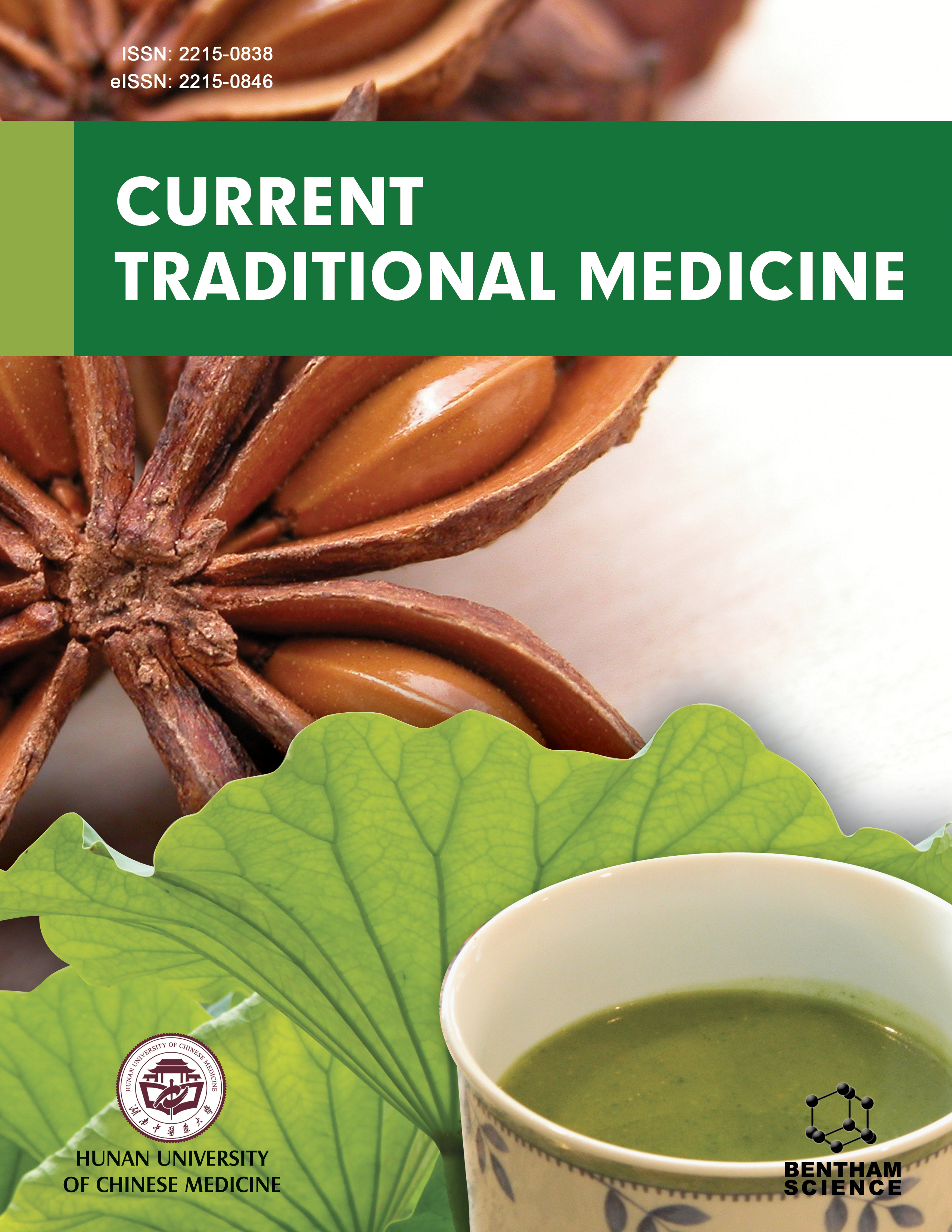- Home
- A-Z Publications
- Current Traditional Medicine
- Previous Issues
- Volume 10, Issue 2, 2024
Current Traditional Medicine - Volume 10, Issue 2, 2024
Volume 10, Issue 2, 2024
-
-
The Herbal Treatment of Osteoarthritis
More LessOsteoarthritis is widely acknowledged as the most common, devastating, and diverse ailment that wreaks havoc on people's lives across the world. In the elderly, it is estimated that 10% of males and 18% of women over the age of 60 are affected and its frequency and incidence are increasing in the present scenario. Herbal medicines appear to be safe and effective with antiosteoarthritic effects that help in increased alleviation Read More
-
-
-
An Update on the Anti-diabetic Functions of Genistein: A Soybean (Glycine max (L.) Merr.) Isoflavone
More LessType 2 diabetes mellitus (T2DM) is a developing worldwide issue. Traditionally, different plants have been used throughout history to lower blood glucose and improve the impact of diabetes. Also, today, many natural products have been introduced to lower blood glucose in T2DM patients. The beneficial effects of genistein, the most essential and abundant isoflavone of soybean (Glycine max (L.) Merr.), on blood glucose and Read More
-
-
-
A Comprehensive Review on Elaeocarpus floribundus Blume
More LessAuthors: Bharati Sarjerao Borase and Santosh S. SuranaElaeocarpaceae comprises of 615 species in 12 genera which belongs to angiosperm. It is a tropical and subtropical family with few genera extending into the temperate zone. The genus Elaeocarpus consists of about 350 species distributed through Eastern Asia and the Pacific region. Around 2 genera and 33 species of the family are distributed in India. Elaeocarpus floribundus (family: Elaeocarpaceae), commonly kno Read More
-
-
-
Premna integrifolia: A Review on the Exploration of its Potential Pharmacological and Therapeutic Properties
More LessSeveral Premna species can be found over the entire tropical and subtropical regions of Australia, Asia, and Africa. Many conventional herbal preparations using P. integrifolia (Lamiaceae) have been reported for their potential health advantages. The P. integrifolia is taxonomically ambiguous because of the wide variation in specimens obtained from various geographic locations. The plant is extensively used to trea Read More
-
-
-
Terpenoids and Triterpenoid Saponins: Future Treatment for Depression
More LessBackground: Depression is a crippling mental disorder with high prevalence around the world. The available clinical antidepressants have been effective to a certain degree, and different side effects have limited their application. This leads to the necessity of finding new treatments. Herbal plants are a substantial source of new drug leads. Terpenoid compounds are secondary metabolites representing an enormous category Read More
-
-
-
Redefining Classical Theory of Humours (Akhlat) with Emphasis on Khilt-e-Sauda (Black Bile) Through its Physiological Role
More LessAuthors: Arshi Riaz, Ferasat Ali, Huma Noor and Asim RizviBackground: According to Hippocrates, Akhlat is of four types, i.e., Dam (Blood), Balgham (Phlegm), Safra (Yellow Bile), and Sauda (Black Bile). The correct proportion of these fluids in the body, in terms of quality and quantity, leads to health, while their irregular distribution leads to diseases. The argument presented in this paper will encompass both Tabayi and Ghair Tabayi Sauda.Objective: However, in light of recent advanc Read More
-
-
-
An Overview of the Pharmacological Potential of Curcuma longa
More LessAuthors: Prerna Sharma, Nidhi Rani, Anjali Sharma, Vikas Sharma and Madhukar GargBackground: Various ayurvedic drugs have been widely explored for their therapeutic potencies since ancient times. One of the most significant medicinal plants is Curcuma longa, which is one of the different crude medications. It has a variety of beneficial pharmacological characteristics and has been a staple of Indian cooking for centuries. It exhibits antifungal, antimicrobial, antioxidant, renal, and hepatoprotective activi Read More
-
-
-
The Role of Medicinal Plants in the Treatment and Management of Type 2 Diabetes
More LessAuthors: Tirna Paul, Kalyani Pathak, Riya Saikia, Urvashee Gogoi, Jon Jyoti Sahariah and Aparoop DasDiabetes is a severe metabolic disorder characterized by hyperglycemia. Hyperglycemia is a hallmark of diabetes, a life-threatening metabolic condition. There are a variety of oral hypoglycemic drugs in the market for the treatment of diabetes mellitus, including biguanides, sulphonylurea, and alpha-glucosidase inhibitors. On the other hand, these conventional methods of treating diabetes are costly and associated with a v Read More
-
-
-
Effects of Biofertilizers in Improving the Growth and Development of the Traditional Medicinal Plant Aloe vera L. (Aloe barbadensis Miller)
More LessAuthors: Partha S. Singha, Ramkrishna Ghosh, Syed Benazir Firdaus and Debosree GhoshAloe vera L. (Aloe barbadensis Miller) is a very common water deficit-resistant plant which has immense medicinal properties. It is a fleshy plant belonging to the Liliaceae family. Aloe barbadensis has enormous medicinal value. According to historical records, it has been used in folk and traditional medicine in different parts and regions of the world for ages. Aloe vera is widely used in Ayurvedacharya and Unani medicine. Read More
-
-
-
A Review of Pharmacotherapeutic Potentials of Black seeds (Nigella sativa) in the Management of Monkeypox Infection
More LessAround 3500 laboratory-confirmed cases of monkeypox infection, from 42 non-endemic countries have been reported to World Health Organization (WHO), during the current multicountry monkeypox outbreak. As of now, patients with monkeypox infection are managed symptomatically with supportive care. Hence, our current review focuses on the analysis of the pharmacotherapeutic potentials of black seeds (N. sativa). Th Read More
-
-
-
Phyto-pharmacology of Most Common Indian Culinary Spices and their Potential in Developing New Pharmaceutical Therapies
More LessAuthors: Mubashir Maqbool, Kakul Chaudhary, Rishabh Chalotra, Samrat Chauhan and Randhir S. DahiyaBackground: Culinary spices and Indian kitchens share a historical relationship for centuries. An average Indian kitchen contains a lot of spices like fennel, cardamom, cumin, turmeric, clove, black pepper, etc., used to increase the aroma and taste of food. Scientific research suggested the pharmacological activities of these kitchen spices, as most of them enhance the appetite, digestion, and have anti-inflammatory and an Read More
-
Most Read This Month
Article
content/journals/ctm
Journal
10
5
false
en


